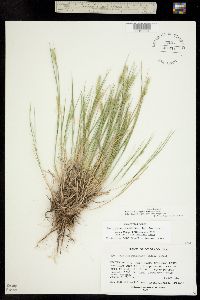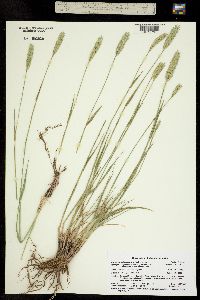Agropyron cristatum subsp. desertorum
|
Agropyron cristatum subsp. desertorum (Fisch. ex Link) A. Löve
 (redirected from: Agropyron desertorum (Fisch. ex Link) J.A. Schultes) (redirected from: Agropyron desertorum (Fisch. ex Link) J.A. Schultes) |
|
|
Family: Poaceae
desert wheatgrass, more...clustered wheat grass
[Agropyron cristatum var. desertorum (Fisch. ex Link) Dorn, moreAgropyron desertorum (Fisch. ex Link) J.A. Schultes] |
Dr. David Bogler, USDA NRCS PLANTS Database Perennials, Terrestrial, not aquatic, Stems nodes swollen or brittle, Stems erect or ascending, Stems caespitose, tufted, or clustered, Stems terete, round in cross section, or polygonal, Stem internodes hollow, Stems with inflorescence le ss than 1 m tall, Stems, culms, or scapes exceeding basal leaves, Leaves mostly basal, below middle of stem, Leaves mostly cauline, Leaves conspicuously 2-ranked, distichous, Leaves sheathing at base, Leaf sheath mostly open, or loose, Leaf sheath smooth, glabrous, Leaf sheath hairy, hispid or prickly, Leaf sheath and blade differentiated, Leaf blades linear, Leaf blade auriculate, Leaf blades 2-10 mm wide, Leaf blade margins folded, involute, or conduplicate, Leaf blades mostly glabrous, Leaf blades more or less hairy, Leaf blades scabrous, roughened, or wrinkled, Ligule present, Ligule an unfringed eciliate membrane, Inflorescence terminal, Inflorescence racemose, Inflorescence simple spikes, Inflorescence a dense slender spike-like panicle or raceme, branches contracted, Inflorescence solitary, with 1 spike, fascicle, glomerule, head, or cluster per stem or culm, Inflorescence lax, widely spreading, branches drooping, pendulous, Inflorescence spike ovoid, lanceolate, or oblong, not more than twice as long as wide, Inflorescence single raceme, fascicle or spike, Inflorescence spikelets arranged in a terminal bilateral spike, Flowers bisexual, Spikelets pedicellate, Spikelets laterally compressed, Spikelet 3-10 mm wide, Spikelet less than 3 mm wide, Spikelets with 3-7 florets, Spikelets solitary at rachis nodes, Spikelets distichously arranged, Spikelets all alike and fertille, Spikelets bisexual, Spikelets disarticulating above the glumes, glumes persistent, Spikelets disarticulating beneath or between the florets, Rachilla or pedicel hairy, Rachilla or pedicel glabrous, Glumes present, empty bracts, Glumes 2 clearly present, Glumes equal or subequal, Glumes shorter than adjacent lemma, Glumes awned, awn 1-5 mm or longer, Glumes keeled or winged, Glumes 1 nerved, Glumes 3 nerved, Lemma 1 nerved, Lemma 3 nerved, Lemma glabrous, Lemma apex acute or acuminate, Lemma mucronate, very shortly beaked or awned, less than 1-2 mm, Lemma distinctly a wned, more than 2-3 mm, Lemma with 1 awn, Lemma awn less than 1 cm long, Lemma awned from tip, Lemma awns straight or curved to base, Lemma margins thin, lying flat, Lemma straight, Palea present, well developed, Palea membranous, hyaline, Palea about equal to lemma, Stamens 3, Style FNA 2007, Utah Flora 1983, Field Guide to Forest & Mt. Plants of N Ariz 2009 Common Name: desert wheatgrass Duration: Perennial Nativity: Non-Native Lifeform: Graminoid General: Introduced perennial, densely tufted, stems 25-110 cm tall, with spikes to 10 cm long consisting of 2-ranked overlapping spikelets. Vegetative: Sometimes rhizomatous, stems 25-110 cm tall, often more than 40 cm tall, usually nearly equal in height,erect; blades flat, 5-20 cm long, 2-6 mm wide, glabrous or pubescent; ligules <2 mm long, membranous, sheaths glabrous, but lower ones can be hairy. Inflorescence: Spikes 1-10 cm long, 5-25 mm wide, lanceolate or ovate, with 2-ranked, closely overlapping spikelets, 7-16 mm long, spikelets with 3-6 florets, glumes 3-6 mm long, 3-veined, glabrous or with hairs on the keels, usually awned, awns 1-3 mm long, lemmas 5-9 mm long, glabrous or with hairs, with acute and usually awned apices, awns 1-6 mm, anthers 3-5 mm. Ecology: Found on dry range lands and disturbed soils, is shade and drought tolerant, grows early in the season, then becomes dormant and will resume growth in the fall if there is sufficient moisture; grows at an elevation of 1500-3700 m (5000-9000 ft); flowers Distribution: Throughout the western and northern United States. Notes: Is easy to establish so has been widely used throughout the West to restore productivity in overgrazed, disturbed, or burned areas. However, since it is very long-lived, persisting for decades, it may interfere with establishment of both native and non-native species. Is highly palatable to livestock, particularly during the spring. Is native to Europe, the eastern Mediterranian, Mongolia, and China. It is differentiated from A. fragile by having awned lemmas and having spikelets diverging from the rachises at 30-95 degree angles, while A. fragile have unawned lemmas, and spikelets diverging at angles of less than 30 degrees. Also, it differs from A. cristatum by having spikelets that are strongly ascending (vs. ultimately diverging from the rachis at wide angles), stems are often more than than 40 cm tall and are uniform in height (vs. less than 40 cm tall and of variable heights), and are straight, not bent. Ethnobotany: Unknown Etymology: Agro is from Greek agros for field, and pyron is from Greek puros, wheat. Desertorum refers to the plant's desert-like habitat. Synonyms: Agropyron cristatum ssp. desertorum, Agropyron cristatum var. desertorum Editor: Lkearsley, 2012 |


































































































